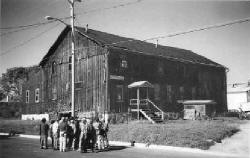©1999-2015
Wisconsin Pottery Association
P.O. Box 705
Madison WI 53701-0705
Pauline Pottery
Chicago Illinois
1883-1888
Edgerton Wisconsin
1888-1911
The following article appeared the WPA
Press, Vol. 2, September 1999
In October of 1998 members of the Arts Council of Edgerton
(ACE) hosted the Wisconsin Pottery Association for a tour of Edgerton, which
featured landmarks of Edgerton's rich history in the pottery business. A
highlight of the tour included viewing the log cabin that Pauline Jacobus used
as a studio for her art pottery. The log cabin, dating back to the 1840's, was
in deteriorating condition and in danger of being lost to expected development
of the land. The tour also included the small pond in which the clay was
collected near the building that housed the Pauline Pottery Company. Plans had
been laid out for the development of this area for recreational park space and
the addition of a historical/educational aspect to the project was a perfect
match. It was suggested that the cabin be relocated to the park and be the
centerpoint of a historical site dedicated to the reclamation of the city's rich
and important history in the pottery industry. The log cabin was generously
gifted to the ACE and plans are underway to dismantle it for storage until the
remainder of the park project is completed and money can be raised to rebuild
the cabin in it's new location. Funds and volunteer assistance are being sought
to create a historical marker for the site as well as pay for the rebuilding and
maintenance of the building. Rick Petersen of the ACE is overseeing the project. ACE is interested in eventually starting a museum that will
feature Pauline Pottery. Ori-anne Pagel, Member of ACE, the WPA and a prominent
antiques dealer in Edgerton, along with her husband Paul, credits the people of
Edgerton for their forward thinking and assistance in making the project happen.
She notes that everything that is being done has been completed on a volunteer
basis but that much more is left to be done to bring the project to fruition.
Yet to be developed is the possible archeological excavation of the kiln site to
study the history of the pottery. Ori-anne credits the owners of the property,
Al Pope and Lars Lien, for their contributions. They not only donated the cabin,
but also historical information and documents related to the history of the
property, and they have indicated a willingness to continue to assist with
projects, such as the possible excavation of the site.Pottery News from Wisconsin:

Members of the Wisconsin Pottery Association and the Arts Council of
Edgerton outside the Pauline Pottery factory building in Edgerton, Wisconsin,
October 1998. The decorating studio was housed on the top floor of the building,
with manufacturing and shipping on the lower floors. The article below describes
a separate, log cabin, which was used as the pottery at one time. Photo courtesy
of Nicol Knappen.The Pauline Pottery
--Barbara Huhn, WPA Vice-President
About the Pauline Pottery
The Pauline Pottery business was established in Chicago in 1882. The founder of the pottery was Pauline Jacobus who originally learned her trade at the Rookwood Pottery. In 1888 the business was moved to Edgerton, WI to be near a suitable source of white clay (early pieces were made with red clay). Pauline pottery was considered to be high quality ware, imitating designs and styles of Wedgwood and Meissen, and was sold at leading department stores, including Tiffany's in New York, Kimball's in Boston and Marshall Field's in Chicago.The pottery closed in 1893. Following bankruptcy proceedings a new business, the Edgerton Pottery, took over the Pauline Pottery operation. The Edgerton Pottery also failed. At that time Pauline Jacobus purchased one of the six kilns, moving it to her Edgerton home. Mrs. Jacobus produced Pauline pottery and conducted summer schools in pottery art at her residence from 1902 until approximately 1909. The business finally ended in 1911 after a fire destroyed her home and studio. Pauline Jacobus died in 1930.
The two most common types of Pauline decoration are a thick slip and an outlined water-color style, both covered by glaze. The thick slip variety can be found on either white or red clay, while the water-color decorating was done on white clay. Almost all of the pieces have a very fine crazing. Some of the water-color examples appear to have started the crazing process while the glaze was still molten, creating small glaze filled valleys between plateaus. The red clay used is similar in appearance to that produced at Rookwood.
Many pieces of Pauline Pottery are unsigned. Features for
identification are:
-a very fine crazing
-a cream colored clay under the glaze, an ivory clay unglazed
-outlined, water-color decorations
-gold trim
-decorations done in thick slip
-red clay for some pieces
From:
American Art Pottery by Dick Sigafoose and Art Pottery of the Midwest by Marion NelsonRelated Pages:








